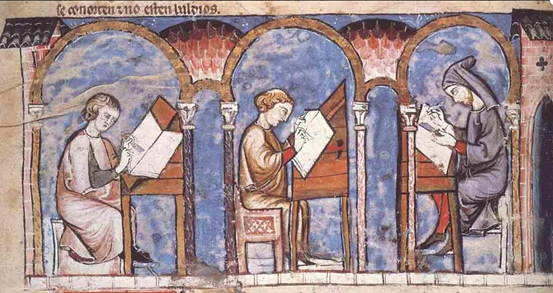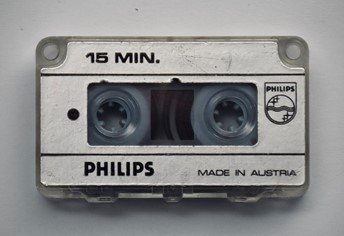Since ancient times, scribes have been indispensable and respected members of society because they were among the few who could read and write. In the Middle Ages, some scribes were employed by the court, others lived in monasteries and, in addition to legal documents, were responsible for all correspondence, keeping chronicles and making copies of manuscripts. Visit Manuscripts Online so you can see what some of these texts looked like.
Although the image of scribes copying manuscript after manuscript by candlelight has been somewhat romanticized, it is undeniable that the work was gruelling and the scribes’ dedication and craftsmanship unparalleled.
The beginnings of shorthand
However, capturing the spoken word is a discipline in its own right, which is why shorthand (a system of symbols that can represent syllables, words or vowels) was developed in ancient Greece to make the process of writing down human speech as fast and accurate as possible.
Incidentally, did you know that there are nearly seventy such systems? Most of them were developed for English, while the Herout-Mikulík system, which was introduced only in 1921, is used for Czech and Slovak (while no shorthand system was widespread in the Czech lands until the mid-18th century).
Follow the link to read more about the history and development of shorthand.

Towards the end of the 19th century, with the advent of new technologies, the work of scribes slowly began to transform.
The mechanical typewriter, which became a staple in most offices by the end of the 19th century, made writing considerably faster and helped ease the workload of scribes and secretaries. The next major shift came in 1978 with the introduction of the electronic typewriter, which included a simple display and basic software that allowed a line or paragraph to be edited before it was printed on paper.
The possibility of recording speech and replaying it later was a significant help for typists. The first sound recording device was the phonograph which appeared in the late 19th century and recorded sound by engraving on wax cylinders. However, its use was not widespread due to availability and certain technical limitations.
In 1935, the German manufacturer AEG introduced the first tape recorder to the market, a sound recording device which used magnetic tapes. From there, the next step was the introduction of the compact audio cassette in 1963, which was a great solution for portable dictation devices. These new technologies made work easier for a number of professions including typists, secretaries, and journalists.

Audio cassette for portable dictaphones, made in Austria in the 1970s
The most significant changes have taken place in the last 20 years, due to the widespread use of personal computers, digital dictation devices and speech technologies.
The last twenty years have borne witness to increasingly powerful computers, sophisticated word processing programs, and ever-improving sound quality from digital voice recorders. Nevertheless, from a typist-stenographer\’s perspective, one of the most significant advances can be attributed to research and development in the field of speech technology. Software based on Automatic Speech Recognition (ASR) technology that enables the conversion of audio recordings to written text has the potential to completely change the face of the stenographer’s craft.
With the advent of dictation transcription software, the focus of a typist’s work has shifted to checking and editing the resulting text, which in turn has introduced opportunities for more interesting and varied work. The professional court reporter Marie Heřmánková, who works as a registry manager at the Litoměřice District Court, has had her fair share of experience with this.
Marie began working at the district court eight years ago as a court reporter in the criminal division, and even over this relatively short span of time there has been a significant shift, as she describes, “A lot has changed in the few years that I’ve been at the district court; the amount of work, new statutes and regulations, but also new programs that make the stenographers’ jobs faster and easier, such as the APSTR software and the Beey program that is currently gaining popularity.”
Because she had always been interested in administrative work, Marie went to study business management. Although it was not so long ago, it would be hard for students nowadays to imagine working with the technology that was available back then: “At school, the most modern technology that I encountered was an electric typewriter, which made a terrible noise, and I only got access to a computer sporadically, since computers were used only rarely in programming classes,” she recalls. So, what about new technologies today? “Every new thing that comes to our institution surprises us; some people are negative about it from the very beginning, while others try it out immediately and then make up their own minds. As soon as I tried Beey I knew that it would save me the work and time processing files I needed for managing my entire senate’s agenda.”
Understandably, innovation can often go hand in hand with mistrust or fear of the unknown. Typists and stenographers, for example, fear that a machine could partially or even completely replace them. But new technologies can never fully replace typists, although they can make their jobs much easier and save them time which can then go towards other important activities, thus expanding their work portfolio and bringing a more diverse range of tasks.
„I would say that this program [Beey] is addictive, because once you give it a chance, you’ll discover that you don’t want to settle for anything less.“
If a recording is of inferior quality, or when a word is spoken in an unusual context, very funny confusions can sometimes occur. “The transcription software is very good, and I like that if it doesn\’t understand the dictated word, it will write a possible alternative, which can be quite humorous – so I even have quite a bit of fun while transcribing. For example, the abbreviation OSPOD was transcribed as hospod (pub), the academic title Mgr. as Bagr (excavator), veganství (veganism) became vinařství (winery), and so on.” Well, even the most advanced technology can\’t manage without a bit of manual proofreading.
As Maria Heřmánková\’s personal experience shows, typists and stenographers continue to be indispensable professionals, and their long history shows that their craft always has been – and will be – highly valued, innovative technologies notwithstanding.